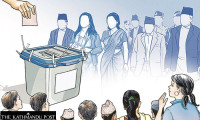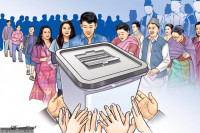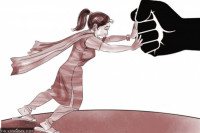The government has decided to cut the electricity tariff by 20 percent for those households whose power consumption is up to 150 units a month. The decision comes as people are queuing up outside cooking gas depots for hours on end amid the lockdown orders issued by the government to stem the spread of Covid-19.
The high-level coordination committee on Covid-19, led by Deputy Prime Minister Ishwar Pokhrel, on Wednesday had decided to encourage the people to use induction stoves instead of gas. The meeting had directed the Ministry of Finance and the Ministry of Energy, Water Resources and Irrigation to take necessary measures to offer concessions on electricity tariff and customs duty.
According to the officials at the Ministry of Finance, the ministry has decided not to charge 15 per cent customs duty on the induction stoves.
The high-level committee has also decided to open the two border points with China— Rasuwagadhi and Tatopani—to facilitate the import of essential goods.
The Ministry of Home Affairs and the Ministry of Finance have been given the responsibility of ensuring that the daily essentials are transported safely.
Energy Minister Barsaman Pun said the decision to open the two border points was not for the import of goods other than the essentials such as induction stoves, medical equipment and foodstuffs.
The government has also asked the traders of daily essentials to start home delivery services during the lockdown period.
To this end, the Ministry of Home Affairs has asked the board members of the Federation of Nepalese Chambers of Commerce and Industry, supermarket operators, grocers and wholesale traders to deliver daily essentials to people’s doorsteps.
The decision was taken after the officials from the Ministry of Home Affairs and the Ministry for Industry, Commerce and Supplies held a discussion among the industrialists and entrepreneurs, owners of the major supermarkets, groceries and food stores of Kathmandu and officials of the Kathmandu Metropolitan City.
The Ministry of Home Affairs has agreed to issue travel passes to those businesses offering home delivery service.
For similar management outside the Kathmandu Valley, the Home Ministry has told the concerned district administration offices and local units to coordinate with their local grocers and traders.
Frequently asked questions about the coronavirus outbreak
UPDATED as of September 22, 2020
What is Covid-19?
Covid-19, short for coronavirus disease, is an illness caused by the coronavirus SARS-CoV-2, short for severe acute respiratory syndrome coronavirus 2. Common symptoms of the disease include fever, dry cough, fatigue, shortness of breath and breathing difficulties. In severe cases, the infection can cause pneumonia, severe acute respiratory syndrome, kidney failure and even death.
How contagious is Covid-19?
Covid-19 can spread easily from person to person, especially in enclosed spaces. The virus can travel through the air in respiratory droplets produced when a sick person breathes, talks, coughs or sneezes. As the virus can also survive on plastic and steel surfaces for up to 72 hours and on cardboard for up to 24 hours, any contact with such surfaces can also spread the virus. Symptoms take between two to 14 days to appear, during which time the carrier is believed to be contagious.
Where did the virus come from?
The virus was first identified in Wuhan, China in late December. The coronavirus is a large family of viruses that is responsible for everything from the common cold to Middle East Respiratory Syndrome (MERS) and Severe Acute Respiratory Syndrome (SARS). After an initial outbreak in Wuhan that spread across Hubei province, eventually infecting over 80,000 and killing more than 3,000, new infection rates in mainland China have dropped. However, the disease has since spread across the world at an alarming rate.
What is the current status of Covid-19?
The World Health Organisation has called the ongoing outbreak a “pandemic” and urged countries across the world to take precautionary measures. Covid-19 has spread to 213 countries and territories around the world and infected more than 31,405,983 people with 967,505 deaths and 22,990,260 recoveries. In South Asia, India has reported the highest number of infections at 5,557,573 with 88,943 deaths. While Pakistan has reported 306,304 confirmed cases with 6,420 deaths. Nepal has so far reported 65,276 cases with 427 deaths.
How dangerous is the disease?
The mortality rate for Covid-19 is estimated to be 3.6 percent, but new studies have put the rate slightly higher at 5.7 percent. Although Covid-19 is not too dangerous to young healthy people, older individuals and those with immune-compromised systems are at greater risk of death. People with chronic medical conditions like heart disease, diabetes and lung disease, or those who’ve recently undergone serious medical procedures, are also at risk.
How do I keep myself safe?
The WHO advises that the most important thing you can do is wash your hands frequently with soap and water for at least 20 seconds or use hand sanitizers with at least 60 percent alcohol content. Avoid touching your eyes, nose and mouth with unclean hands. Clean and disinfect frequently used surfaces like your computers and phones. Avoid large crowds of people. Seek medical attention if symptoms persist for longer than a few days.
Is it time to panic?
No. The government has imposed a lockdown to limit the spread of the virus. There is no need to begin stockpiling food, cooking gas or hand sanitizers. However, it is always prudent to take sensible precautions like the ones identified above.





 16.12°C Kathmandu
16.12°C Kathmandu















